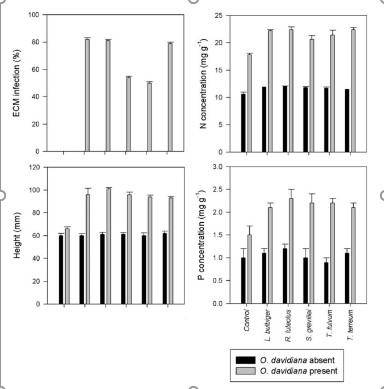
Increasing Survival Rates during Forest Restoration with Chinese Pine under Harsh Conditions through Mycorrhizal Networks
Details
The Chinese Pine (Pinus tabuliformis) is one of the most commonly selected trees for afforestation and forest restoration efforts in northern and northeast China, including the area in the Miyun watershed, where together with Oriental Thuja (Platycladus orientalis) it forms the main tree species in man-made afforestation. While through previous reforestation programs many areas have forest cover already, in some areas afforestation has been avoided due to degraded soil and generally hostile growth conditions. Afforestation with Chinese Pine on arid and poor sites is limited, often because seedlings experience high levels of stress. Immediately after outplanting conifer seedlings for either afforestation or reforestation, rapid initiation of new roots is essential to alleviate seedling stresses. The connection to mycorrhizal networks (MN) and mycorrhizal associations in general have shown to improve many aspects of growth and survival, for example net photosynthesis rate and water use efficiency, effectively mitigating post-planting stress resulting from afforestation.
A recent study by Shu-Lan et. al (2008) conducted at Danqing Mountain, Inner Mongolia and about 400km west of Beijing, has shown that in many areas in the Northeast (Sichuan, Hebei, and Inner Mongolia provinces), where Hazel-Hornbeam (Ostryopsis davidiana), a small shrub forming sparse forests or thickets, and Chinese Pine are naturally occurring together, but are not planted together Chinese Pine is often not able to access the local mycorrhizal network. This hampers growth, the chance for long-term survival and ultimately the success of the forest restoration goals. However, planted together Chinese Pine not only has access to a variety of fungal species in the MN, it’s survival rate increases (85%), even on harsh and dry sites, together with many more advantages (see Fig. 1).
It is therefore recommended that when Chinese Pine is used during forest restoration activities in areas where it naturally occurs together with Ostryopsis, Ostryopsis should be interplanted. If the soil is deficient of mycorrhizal fungi, the species described in the study by Shu-Lan et. al. (2008) should be considered as an enrichment component. In the study the species used to successfully form MNs with Pinus through Ostryopsis were: Leucocortinarius bulbiger, Rhizopogon luteolus, Suillus grevillei, Tricholoma fulvum, and Tricholoma terreum.
Source:
Bai, S.-L., et al. (2009). "Ostryopsis davidiana seedlings inoculated with ectomycorrhizal fungi facilitate formation of mycorrhizae on Pinus tabulaeformis seedlings." Mycorrhiza 19(6): 425-434.
